Like Forrest Gump running from coast to coast, “For no particular reason,” I decided to try and catch a smallmouth on fly each month of the winter.
I’m lucky to live between the Juniata and Susquehanna rivers, world-famous smallie waters that stay liquid through the cold months. Still, winters in central Pennsylvania are brutal.
Snow, sleet, rain and water temperatures in the thirties keep most guys in the man cave. The fishing is also tough. Coldwater gives the fish lockjaw; success will take a hundred hours and a thousand casts.
Through the ordeal, I kept a careful log of my successes and failures. What started as a personal challenge turned into a learning experience and one hell of a fish story.
Fly Fishing For Bass In November
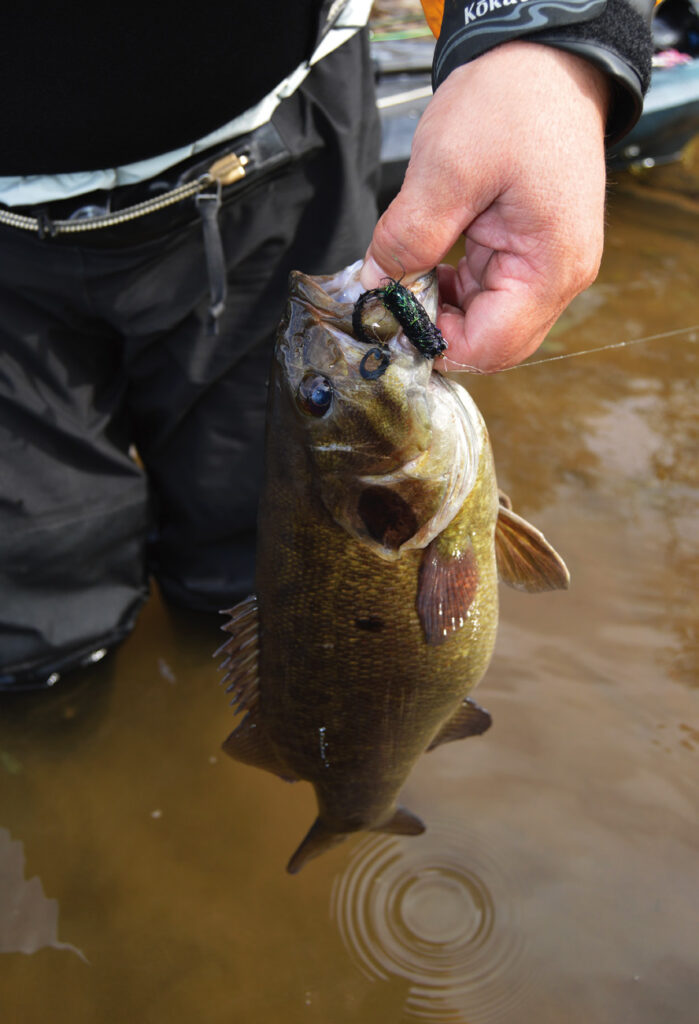
WEATHER CONDITIONS: Sunny and warmer than usual.
WATER CONDITIONS: A little higher than normal and stained with low visibility.
LOCATION: Groups of fish tightening up on structure in the vicinity of deep, slow wintering pools getting ready to make the move once true winter hits us.
LOCATION PATTERN: Deep pockets of water around submerged small grass islands.
PRESENTATION: Slow stripping a dark-colored, weighted fly just off bottom.
ROD & REEL: Nine-foot, 8 wt. Orvis Clearwater with size IV Orvis Access reel. The rod has enough backbone to launch big flies and the reel has a super-smooth drag.
LINE: Orvis Access Weight Forward Floating to turn over big flies.
LEADER: 7.5-foot 2X nylon tapered leader, 12 inches of 10-pound fluorocarbon tippet
Water at mid-level, so the fish could be anywhere. I cheated to swing the pendulum in my favor. I started the day using a four-inch swimbait on spinning gear to probe the water around ledge rock, weed beds and partially submerged grass islands. I started hitting fish around grass islands with deep-water pockets. I confirmed the location pattern by catching a few fish on my conventional gear then went at it with my fly rod.
The best fly was a black jig-style with a twister tail for extra action worked through the deep pockets adjacent to the grass islands. Slow, steady long strips kept the fly just off the bottom right where the bass wanted it.
PROBLEM: Fly line gets caught on everything!
SOLUTION: Use a boat with an open deck. Slide your foot pegs all the way forward. Keep rod holders and gear behind you.
Fly Fishing for Bass In December
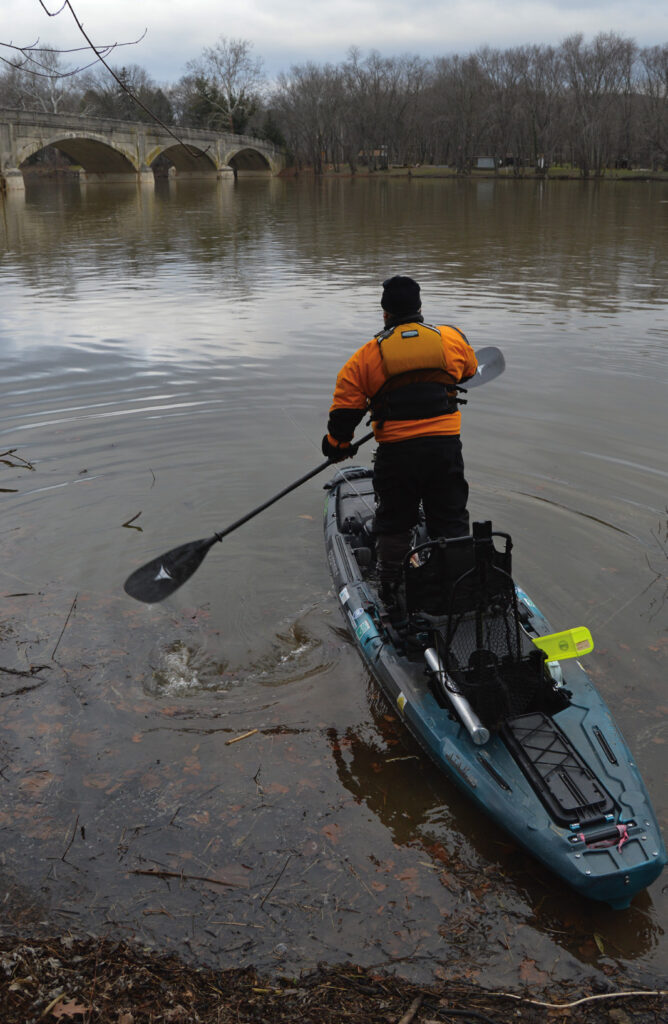
WEATHER CONDITIONS: Overcast, cold, rainy with sleet.
WATER CONDITIONS: High, muddy water with almost no visibility.
LOCATION PATTERN: Front edge of deep, submerged ledges.
PRESENTATION: Swinging ledges.
LOCATION: Fishing a large river today. Smallmouth have moved into deep wintering pools. Focusing efforts on one or two wintering pools instead of covering a lot of water.
ROD & REEL: Seven-foot, 11-inch 8 wt. Orvis Recon with size IV Orvis Access reel. Faster rod casts big fly. Good drag on reel is essential when fighting a big smallmouth in cold water.
LINE: OrvisColdWaterintermediatesinking line. The line remains subtle even in water temperatures in the thirties.
LEADER: Five-foot, 10-pound fluorocarbon, no tapper.
The river level was high and the color of chocolate milk. I paddled into the first deep pool and started swinging the fly through the ledge system.
Very distinct pattern to the location. Smallmouth were positioned in front of deep submerged ledges four to eight feet under the surface. The best ledges were submerged in the top third of deep wintering pools with moderate to slow-moving current.
Swinging my fly across the front of ledges was the best presentation. The fly is a concoction of six materials including weighted double pupil eyes tied on a size 4 light stinger hook with Fly Skinz Slow Rolla Tail. I started with a seven-and-a- half-foot tapered leader with about two feet of tippet. The long leader makes it difficult to control the placement of my fly in front of the ledge. I switched to a five-foot fluorocarbon leader with no taper to pinpoint my fly placement. This enabled me to swing the fly inches in front of the ledge where water stacks up and the lazy winter fish were waiting patiently for an easy meal. I picked up two smallmouth today.
PROBLEM: Difficult to manage more than one fly rod.
SOLUTION: Select a rod that can throw the widest range of flies. Buy extra spools for sinking, intermediate and floating lines.
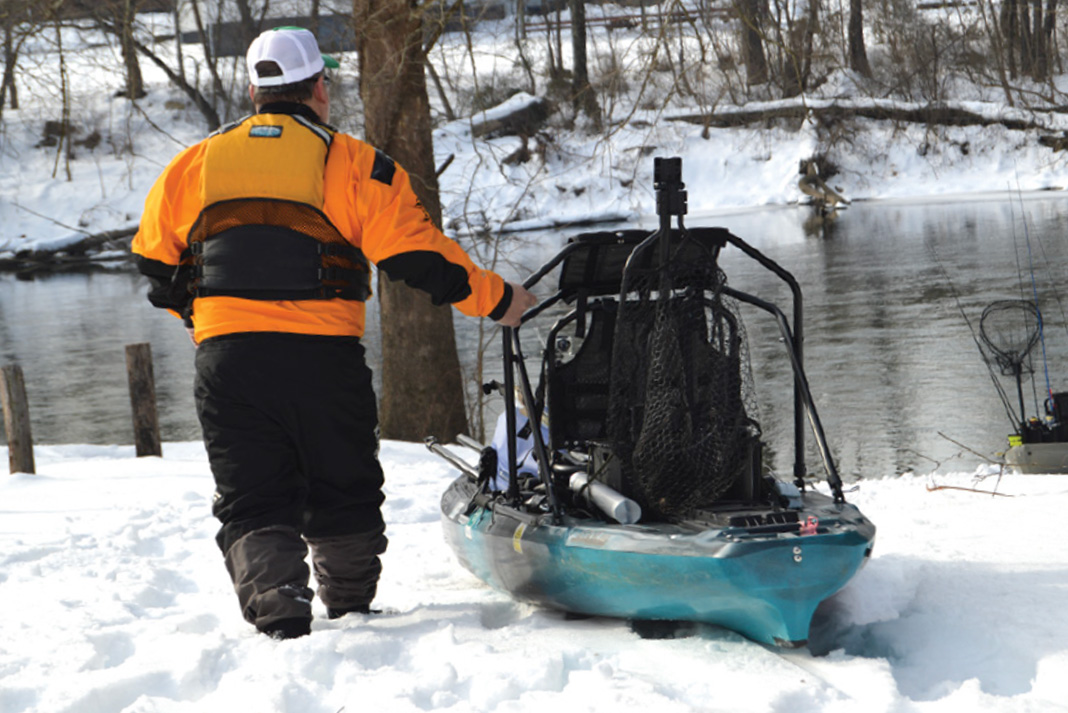
Fly Fishing For Bass In January
WEATHER CONDITIONS: Air temperatures in low twenties with snow.
WATER CONDITIONS: High and green. LOCATION PATTERN: Billowy water on eddy lines.
LOCATION: Fishing a smaller river today. Wintering locations are smaller and hold less fish. Best wintering locations are deep eddies along the bank.
PRESENTATION: Swing and suspend Clouser minnow in eddy line.
ROD & REEL: Seven-foot, 11-inch, 8 wt. Orvis Recon w/ Orvis Access reel.
LINE: Orvis Cold Water intermediate sinking line.
LEADER: Five-foot, 10-pound fluorocarbon, no tapper.
Today was a fun day on the water. There were a few periods of sun but mostly cloudy and gray. The water was high and green due to snowmelt. Water temperature was 36 degrees.
High water moved the smallmouth to six- to eight-foot-deep bank eddies. I fished my fly through the still water of the eddy with no luck. Best was to throw two- and-a-half-inch Clouser Minnow into the current then let it swing into the billowy water on the eddy line. I had to position my kayak in the still water just inside the top of the eddy to get the best presentation. Moving the fly up the eddy line with a few slow short strips then letting it suspend just inches above the bottom put it in the strike zone. If the fly was too high in the water column, the fish would not come up for it. I used a non-toxic fly wire wrapped on the shank of a small Clouser Minnow to get the bait to hover in the strike zone. I caught a few fish today in the frigid January waters.
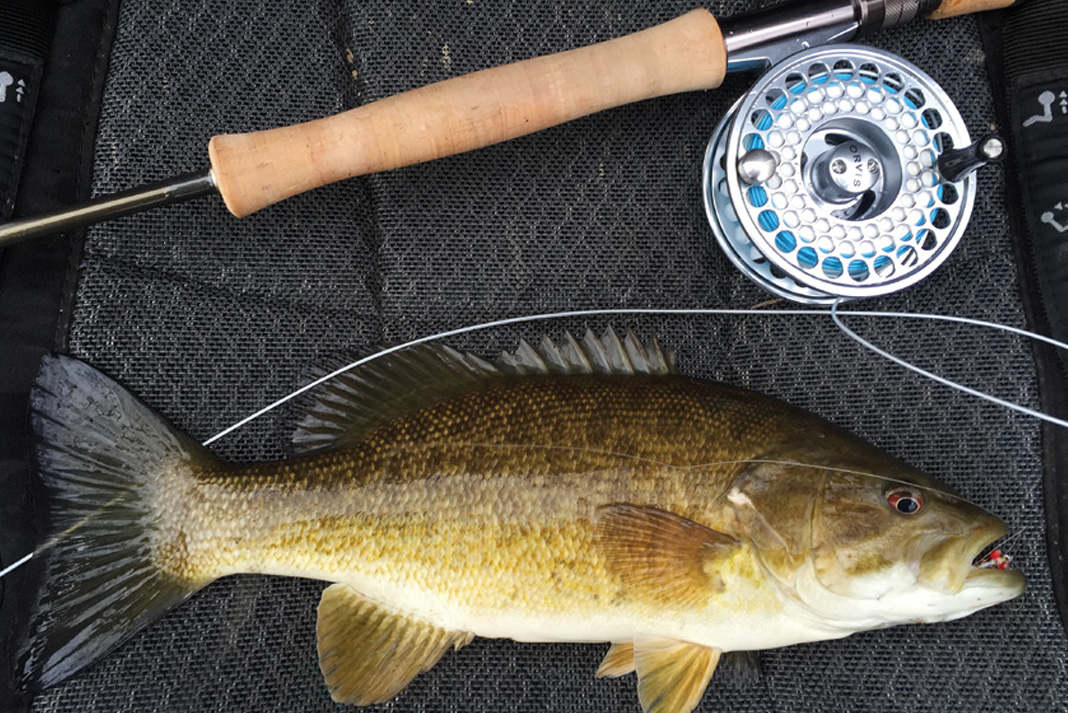
PROBLEM: Sinking a light fly.
SOLUTION: In addition to sinking line, it takes sinking a fly to swing by smallies holding low. Add barbell eyes and wire weight to the fly.
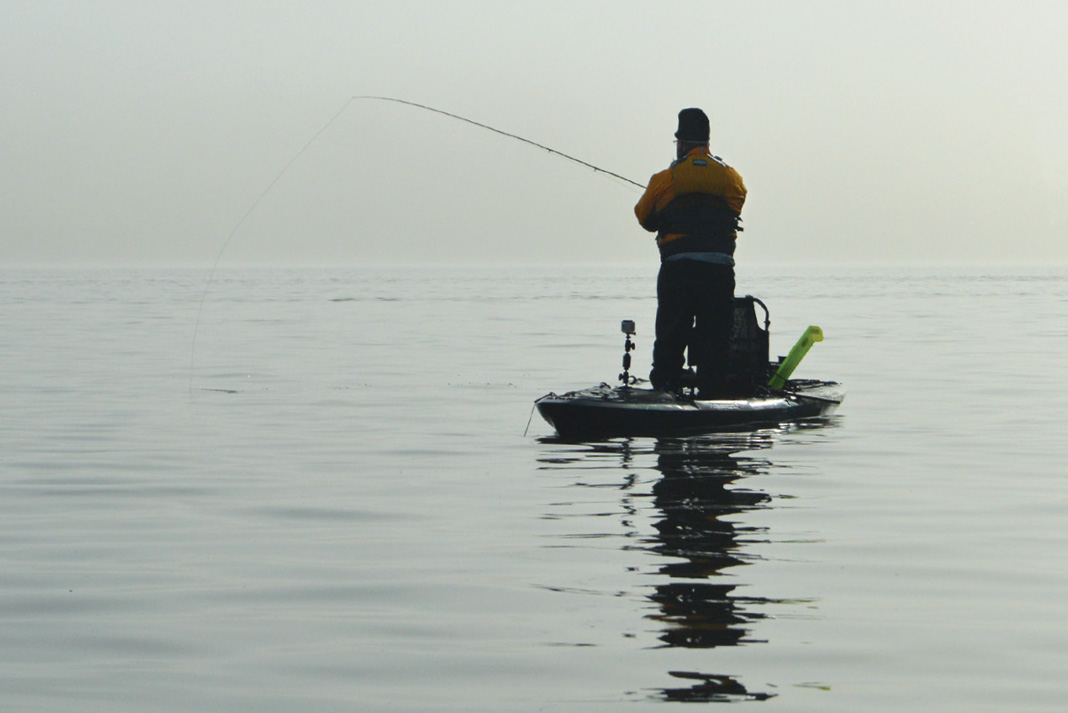
Fly Fishing For Bass In February
LOCATION: I focused all my efforts in a single large wintering pool on the Susquehanna River today.
WEATHER CONDITIONS: Air temperatures in the thirties and cloudy.
WATER CONDITIONS: High, slightly stained.
LOCATION PATTERN: Ledges in the deepest and slowest part of pool.
PRESENTATION: Slow dragging crawfish fly on the bottom.
ROD & REEL: Eight-foot, nine-inch, 8wt.TempleFork Outfitters “The Clouser” with Orvis Access reel.
LINE: Orvis Cold Water intermediate sinking line.
LEADER: Five-foot, 10-pound fluorocarbon, no tapper.
Cold and overcast today. Water temperatures were in the high 30s with a slight stain. The river level was higher than normal but falling slowly.
Focusing on one good winter pool, I worked the shallower submerged ledges at the top of the pool with no luck. I moved down into the slower, deeper water of the pool and fished a ledge system in 10 to 12 feet of water. This was a stretch for the intermediate sinking line and it took forever to get the fly on bottom even in the slow current.
I tried different sizes and colors of streamers with no luck. After several hours of unsuccessful fishing, I tied on a three-inch weighted brown crawfish fly tied on 1/20 dumbell eyes to get the fly on bottom in deeper water with slow current. Moving to the deepest and slowest part of the pool, I made long casts and waited for fly to get on bottom. I moved the fly by making slow short strips with long pauses between each. Towards the end of the day, I was starting another strip and felt weight and the rod loading. I set the hook and immediately felt a series of slow, wide headshakes signaling a big fish. I fought the fish to the side of my kayak with several anglers looking on from the bank. My brain must have been frozen because I made a rookie mistake. Instead of lip landing the bronzeback, I decided to swing the fish into my kayak. All I can remember is holding the tattered leader in my hand and watching the thick-bodied smallmouth swim off into the depths.
PROBLEM: Difficulty managing boat position and making a good presentation.
SOLUTION: Position first then fish. Anchoring in swift water is sketchy, so I wedge my kayak on rock
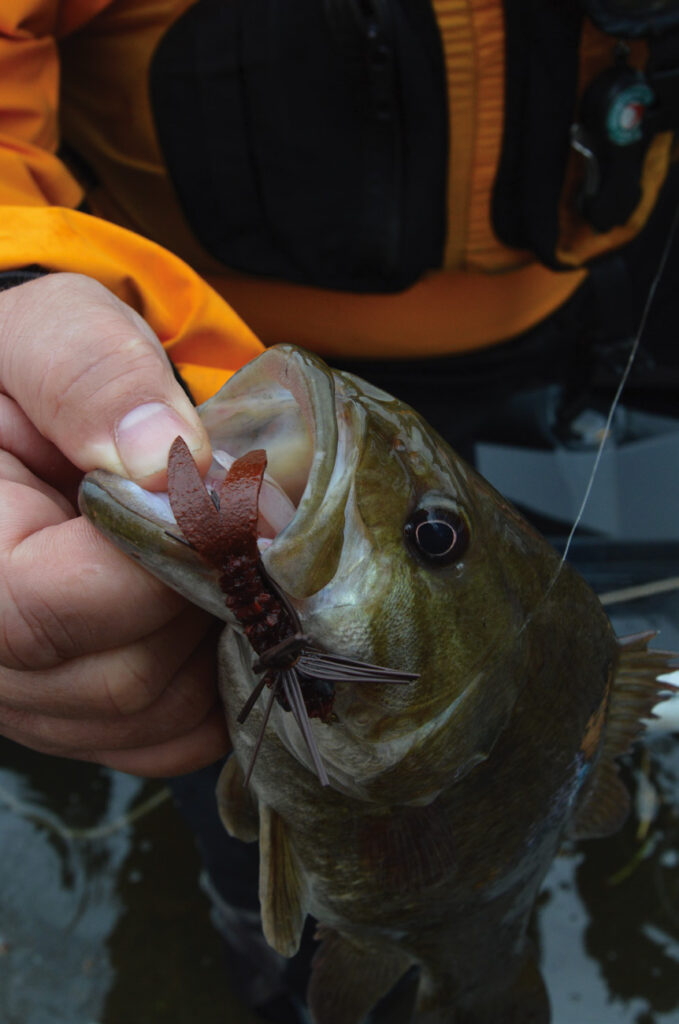 Fly Fishing For Bass In March
Fly Fishing For Bass In March
LOCATION: The river smallmouth are still in their wintering pools but will be moving to the shallower selections of the pools in preparation for the migration to spawning areas. Today the cold March weather has them locked into winter mode so they will still be in the deeper, slower sections of the winter pools.
WEATHER CONDITIONS: Air temperature low forties and cloudy.
WATER CONDITIONS: Stained, rising water. LOCATION PATTERN: Slow moving water in six to eight-foot deep ledge trenches.
PRESENTATION: Slow dragging crawfish fly on bottom.
ROD & REEL: Eight-foot, 8wt. Temple Fork Outfitters “The Clouser” w/ Orvis Access reel.
LINE: Orvis Cold Water intermediate sinking line.
LEADER: Five-foot, 10-pound fluorocarbon, no tapper.
Drysuit weather again! Overcast with cold rain and sleet. Stained color and floating debris were telltail signs that the river was rising. I found smallmouth in slow moving water that was six to eight feet deep. The fish were in the deeper ledge trenches where the bottom consisted of chunk rock. Cold, muddy water made the strike zone small. I expected a light bite and a lot of pick-ups and drops. The best presentation was slow dragging a crawfish fly tied with fabric claws and heavy 1/20-ounce dumbbell eyes. I sweetened the fly by applying crawfish scent to the fabric claws to encourage the smallmouth to hold on longer and give me an extra split second to set the hook.
PROBLEM: Cold fish equals a light bite.
SOLUTION: Sweeten a fly with artificial scent for a stronger bite. Fabric claws on this crawfish absorb scent.
Juan Veruete is a Wilderness Systems pro and guide at Kayakfishpa.com. His book River Kayak Fishing is due out spring 2017.

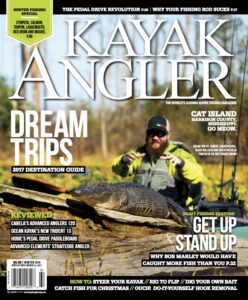 This article was first published in the Winter 2016 issue of Kayak Angler Magazine.
This article was first published in the Winter 2016 issue of Kayak Angler Magazine. 
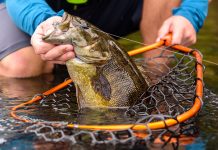
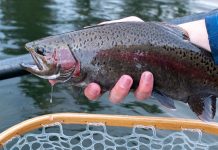
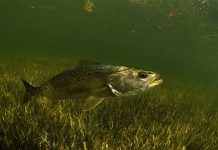


Quite a review. That takes some pretty serious tenacity to hang in there to get it done. I always enjoy Juan’s posts.